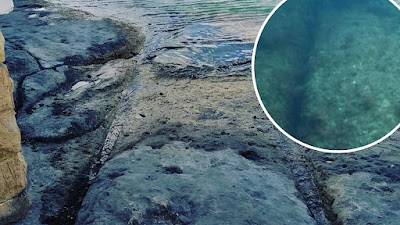Beneath the waters near the uninhabited Chandeleur Islands, located 50 miles east of New Orleans, a retired architect named George Gelé claims to have discovered the remains of a submerged city that dates back 12,000 years. This amateur archaeologist believes that the mysterious granite stones found by local fishermen are actually architectural artifacts from an ancient lost civilization predating the well-known Inca, Maya, and Aztec civilizations of the Americas. Gelé's most astounding assertion is the presence of a pyramid, named "Crescentis," within the granite city, which he believes shares a geographical connection to the Great Pyramid of Giza. While Gelé's claims have been met with skepticism, they have sparked curiosity and debate among experts and locals alike.
Unexplained Granite Stones and Underwater Ruins:
The foundation of Gelé's theory rests on the discovery of strange square rocks made by local fishermen near the Chandeleur Islands. The presence of granite in the area is perplexing since it is not naturally found in Louisiana or Mississippi. Gelé, who has made 44 trips to the site over nearly 50 years, has produced underwater sonar images that he believes reveal discernible ruins of major buildings, including a large pyramid. These findings, covered in sand and silt, fuel Gelé's conviction that an ancient city lies submerged off the coast.
 |
| Where did the granite come from? Credit: WWLTV |
The Electromagnetic Enigma:
Gelé's claims gain further support from eyewitness accounts, such as that of local shrimper Ricky Robin. Robin recalls his boat's compass spinning uncontrollably near the alleged pyramid's location, suggesting an intense electromagnetic energy emanating from the structure. According to Robin, all electronics on his boat malfunctioned in a manner reminiscent of the Bermuda Triangle phenomenon. These intriguing anecdotes add an element of mystery to Gelé's theory and have fuelled speculation about the origin and purpose of the granite structures.
 |
| Are these ruins natural or ma-made? Credit: WWLTV |
Alternative Explanations:
While Gelé's theory captures the imagination, many experts remain skeptical and propose alternative explanations for the granite stones and underwater ruins. A late 1980s Texas A&M study suggests that the granite blocks may have originated from old shipwrecks or served as ballast stones discarded by Spanish and French ships to lighten their load when entering shallow waters. Gelé himself presented similar possibilities in 2014, exploring the idea that the stone piles could be remnants of construction projects or the result of several shipwrecks. LSU archaeology professor Rob Mann suggests that the granite slabs might have been placed there in the 1940s during an attempt to create an artificial coral reef.
The Quest for Scientific Validation:
While Gelé's theory remains unproven, it has garnered attention and curiosity among researchers. However, to obtain serious scientific backing, Gelé's claims require further exploration. Future dives, advanced sonar technology, and satellite imaging could potentially provide the evidence needed to validate or refute his hypothesis. With over 80% of the ocean still unexplored, recent discoveries of ancient ruins and artefacts by underwater archaeologists demonstrate the potential for more extraordinary findings in the future.
George Gelé's assertion of a 12,000-year-old underwater city off the coast of Louisiana has generated excitement and skepticism in equal measure. While Gelé presents intriguing evidence, including the presence of granite stones and underwater sonar images of discernible ruins, alternative explanations propose more conventional origins for these artifacts. The quest for scientific validation continues, and as advancements in technology open up new possibilities for exploration, the mystery surrounding the alleged submerged city near the Chandeleur Islands remains unsolved. As we venture further into the unexplored depths of our oceans, there is always the promise of uncovering ancient civilizations and remarkable artifacts. The underwater world holds countless secrets that have yet to be revealed. Gelé's theory serves as a reminder that our understanding of history is constantly evolving, and there may be undiscovered chapters waiting to be explored.
While Gelé's claims may seem fantastical, it is essential to approach them with a critical lens. Skepticism is a vital part of the scientific process, ensuring that extraordinary claims are subjected to rigorous scrutiny. As experts continue to investigate the origins of the granite stones and underwater ruins, it is crucial to consider alternative explanations proposed by previous studies.
Nevertheless, Gelé's determination and passion for his findings should not be dismissed outright. His relentless pursuit of uncovering a lost civilization serves as a testament to the enduring human curiosity about our past. The allure of an ancient underwater city, complete with a pyramid emitting mysterious energy, captures our imagination and fuels the desire to explore uncharted territories.
The future of underwater exploration holds great promise. Advancements in sonar technology, satellite imaging, and deep-sea diving capabilities provide researchers with unprecedented tools to investigate and document submerged archaeological sites. These advancements may one day provide the conclusive evidence needed to support or debunk Gelé's claims.
Whether Gelé's hypothesis proves to be an accurate interpretation or an elaborate misconception, the pursuit of knowledge and the exploration of our planet's mysteries remain at the forefront of scientific endeavors. The story of the alleged underwater city near the Chandeleur Islands is a reminder that our world continues to hold secrets waiting to be unearthed, and only through dedicated research, open-mindedness, and the relentless pursuit of truth can we hope to unlock the secrets of our past.
Articles you might like:















